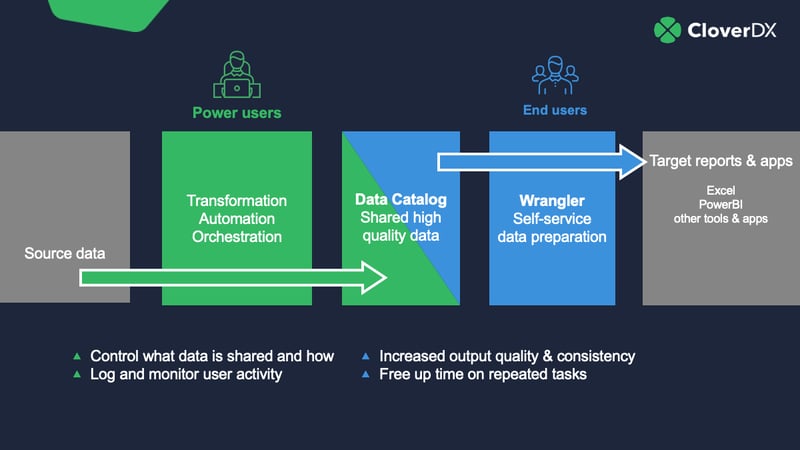"Some people say data is the new oil. My view is that it's like oil in one way, in that it has to be refined to be useful.”
— Hal Varian, Chief Economist at Google
Data — it’s the new oil. Or is it the new gold?
These comparisons have become clichés over the past decade. But the underlying point is as valid as ever: data is a valuable resource. However, data — like oil — is not valuable in its raw state. To use it effectively, you need to transform it into actionable insights.
This can be a complex and time-consuming task — especially if you rely on manual data processing. To extract value from your data without overburdening your teams, you need to implement automated data pipelines.
Read on below to find out how automating your data processes can help turn your data into a source of significant value.
Why your business needs a coordinated approach to data
As your data strategy develops, it’s easy for inconsistencies to emerge. Unforeseen issues demand ad hoc solutions. New applications are layered over legacy systems. Departments adopt their own data processes, which rarely align.
The result? You rely on manual processes to connect the dots, and you face bottlenecks at every turn. Your data is inconsistent, hard to access — and not delivering value. It’s no wonder that 72% of business leaders say that data has paralyzed their decision-making.
Automated data pipelines bring clarity and cohesion to your data processes. They deliver data to wherever you need it, when you need it — while applying automatic validation processes and surfacing quality issues. And by eliminating manual processes, they’ll accelerate your time-to-value, too.
Let’s take a closer look at the benefits automated data pipelines can bring to your business.
The business benefits of automated data pipelines
1. Better business insights
Building the skill set needed to turn data into actionable insights requires significant investment. It means hiring the right people, supporting learning and development, and promoting a data-first culture.
But if your data is siloed in different applications or undermined by quality issues, then all this effort is wasted. Your insights will be outdated, incomplete, and difficult to trust.
Automated data pipelines ensure you have the data you need to develop deep, granular business insights. They allow you to track data from its source and get a clear view of every step, including the validation and cleansing processes that have been applied. And with automated pipelines, these steps will be the same each time, so you won’t need to engage in ad hoc preparation and analysis that could lead to unreliable results.
This means you’ll have the confidence that your data is a reliable source of business insights — and that data quality issues won’t undermine your conclusions.
2. Increased productivity
Senior managers wasting hours creating weekly reports. Experienced developers fielding data access requests. Skilled analysts mired in repetitive data preparation tasks...
These all represent a significant drain on your productivity. The more time skilled staff spend on routine data tasks, the less time they have to devote to business-critical activities.
And this assumes they can get access to data in the first place. If accessing data means an exchange of emails, you’re at the mercy of your IT team’s inbox. You may find yourself waiting for the data you need to progress a critical task.
Automated data pipelines eliminate the most time-consuming and repetitive data tasks. You can streamline your workflows, giving you the time to focus on your key priorities. And you’ll spend less time correcting the errors that manual data handling can introduce.
3. Accelerated time-to-market
In a competitive environment, you need to deliver for your customers — and do it fast. 64% of customers wish companies would adapt more quickly to their changing needs. Any delays in updating your services or your product offering can put your market share at risk.
Data is key to streamlining your product delivery process. Detailed customer data helps you focus on the most impactful changes. Meanwhile, resource utilization and capacity data will help you make the best use of your teams’ time.
However, if your teams use conflicting, siloed processes or incompatible systems, you’ll lack a comprehensive view of your project lifecycle. Insights won’t get shared, and inefficiencies will go undetected.
Automated data pipelines deliver all your business data to wherever you need it, in a transparent, consistent and reliable way. With an end-to-end view of your development process, you can optimize your approach and deliver the most valuable releases faster.
4. Improved customer experience
Delivering an effective customer experience means meeting their ever-changing expectations.
Of course, you need to deliver on the basics: excellent customer service, high-quality products, and timely delivery. Each of these relies on streamlined, consistent processes and careful monitoring of your teams’ performance — you need to be able to see what’s working well, and identify issues as they arise.
And this means you need access to reliable, consistent data from across your organization — which is exactly what automated data pipelines can offer.
But in today’s environment, you need to go above and beyond to stand out from your competitors. And that means delivering on personalization, too. 71% of customers expect companies to offer personalized interactions — and 76% get frustrated when they don’t.
But personalization means more than just auto-filling names in your sales emails. It encompasses everything from targeted product recommendations to tailored messaging and dynamic content.
This kind of deep personalization relies on delivering accurate, up-to-date customer data from multiple sources to your target systems. But if your data processes rely on extensive manual steps, you won’t achieve this at scale.
To make the process easier, you need automated data pipelines. By automatically integrating data from your marketing, sales, and product teams, you can build a comprehensive view of your customers’ behavior. This means you can provide them with an experience that fits their expectations.
Automated data pipelines in action
To give you a clearer view of what automated data pipelines can do for your organization, let’s take a look at two case studies.
Helping Ortec Finance accelerate its reporting process
Ortec Finance used to spend the end of every quarter preparing complex financial reports for clients. As the quarterly deadline approached, staff were rushing to get everything ready. The process was time-consuming and stressful — and it was taking up time that could be spent on delivering more value for clients.
With the help of CloverDX’s data integration platform, Ortec Finance automated most of the report-building process. This reduced manual input by up to 90%, freeing up time and reducing end-of-quarter stress.
“It's really the click of a button and we run the system. Instead of having typically a 4 or 5 day process of people preparing the data, running the models, checking the results and building the reports to send to the clients, we’ve reduced that to half a day or less.”
— Thomas Hage, Senior Consultant at Ortec Finance
Read the full case study here: How Ortec Finance reduced repetitive manual data processes by up to 90%
Freeing up engineer time at Zywave
Zywave were struggling with an elaborate, multi-stage customer onboarding process. Getting customer data from staging to production required extensive input from their engineering team, despite the fact the steps were the same each time.
By using CloverDX to automate the process, Zywave reduced their customer onboarding time by 20%. This not only freed up engineering time but also offered a stronger first impression for customers.
“The onboarding process is our first chance at making a good impression with our customers after the dollars are already spent. And CloverDX gives us a tool to be able to move faster.
— Bryan Kahlig, Senior Director, Product Development at Zywave
Read the full case study here.
Discover your own solution
Automated data pipelines can help you turn your data into a source of competitive advantage, delivering improved customer experience and enhanced productivity. You can fully integrate and validate your data at scale without the need for extensive manual input. Meaning you can access those all-important business insights whenever you need them.
Want to know how automated pipelines could help your business? Get in touch today. We’ve helped countless organizations streamline and optimize their data processes. Now it’s your turn.












